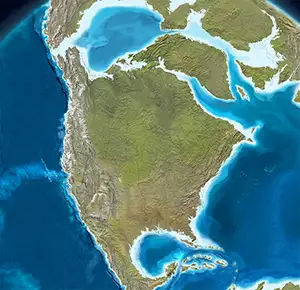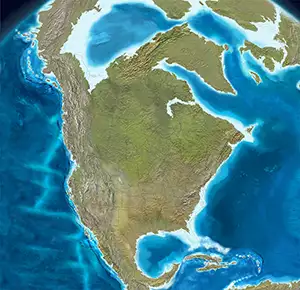The Paleogene Period
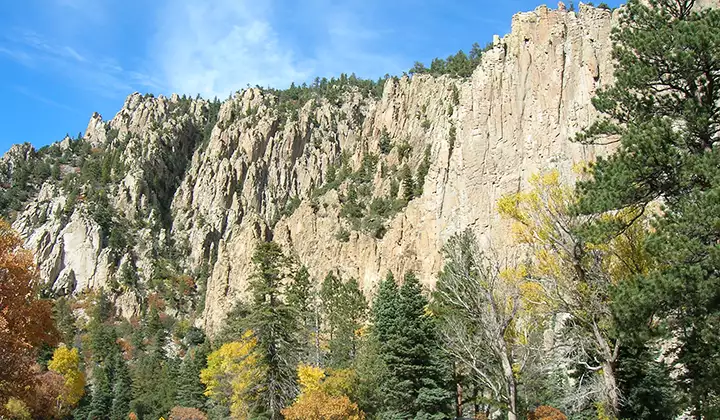
Volcanic Palisades from the Oligocene in Cimarron Canyon, northern New Mexico
The Paleogene Period began with the Cretaceous-Tertiary Extinction Event about 65 million years ago and continued to about 23 million years ago. The previous period was the Cretaceous Period of the Mesozoic Era, the following period the Neogene Period of the Cenozoic Era. This was the time of the rise of mammals. The Period consisted of the Paleocene, Eocene and Oligocene (33.9-23 million years ago) Epochs.
The Paleocene Epoch lasted about 10 million years (from 65 to 55 million years ago), beginning with the major Cretaceous-Tertiary Extinction Event and ending with the Paleocene-Eocene Thermal Maximum (PETM), a minor extinction event during a geologically brief interval (about 200,000 years) of extreme changes in climate and carbon cycling. In a very short period of time, global temperatures rose about 6°C and massive amounts of CO2 were injected into the atmosphere. That led to large species die-offs in the deep seas while it caused the forests and other land surface vegetation to grow like mad. The PETM was a spike in the gradually rising thermal gradient of the planet. Once it peaked, there was a 50,000-year gap and another spike, the Eocene Thermal Maximum 2, occurred. In the explosion of vegetative growth, mammals prospered.
The PETM is often compared to what's happening in today's climate as it was the most recent period in time when planetary and atmospheric conditions approximated today's. That said, the planet back then was essentially ice-free and the rise in CO2 was less, at its worst, than it is today. There was a massive increase in marine vegetation on the continental shelves but there was no accompanying rise in sea level as there was no water trapped in ice.
The Eocene Epoch began at the boundary of the PETM, a minor mass extinction event, and ended at the Eocene-Oligocene Extinction Event (from about 55 million years ago to about 33.9 million years ago). The early Eocene suffered the warmest global climate of the Cenozoic Era. It ended in an icehouse climate with glaciation spreading rapidly across Antarctica.
About 35 million years ago an extraterrestrial object impacted the Earth in the area of Chesapeake Bay. The impact vaporized the object and left a crater about 50 miles across and more than 3/4 mile deep. Much of today's Chesapeake Bay is the result of slumping and sedimentation since that time. There is a smaller impact site located about 200 miles to the north, on the continental shelf off the coast of New Jersey, also dated to the late Eocene. A third impact site, significantly larger and located in Siberia, has also been linked to the time period and to the extinction event.
The Oligocene epoch began at the height of the extinction event about 33.9 million years ago and continued to about 23 million years ago, to the transition to the Miocene Epoch of the Neogene Period. The beginning of the Oligocene was also marked by a mass migration of Asian species of plants and animals to replace dying/dead species in both the Europe and China of those days.
Tectonically, the Atlantic and Gulf Coasts were relatively passive through the period. Early on Greenland rifted from the Laurentia craton, rotating around its northern margin and generating fold and fault belts in the east Arctic region: the Eurekan orogeny. The North Atlantic and East Arctic Oceans widened slowly. As the North Atlantic opened the Caribbean Plate expanded eastward. Erosional detritus from the Rocky Mountains caused deposition of extensive wedges of sediment into Gulf of Mexico throughout the period.
On the West Coast, the Farallon Plate underwent shallow subduction, causing strong thrusting and expansion northeast of the Sevier foreland basin followed by foreland uplifts: the Laramide orogeny began about 65 million years ago with the Rocky Mountain foreland uplift, deformation and shallow-subduction-related magmatism. For many years interior sedimentation was mostly restricted to Rocky Mountain foreland basins (Uinta, Green River, etc), then sedimentation spilled eastward onto the High Plains. The Colorado Plateau was uplifted in the beginning of the Paleogene but by ~25 million years ago, it had been heavily dissected and coarse conglomerates were deposited along the southern margin.
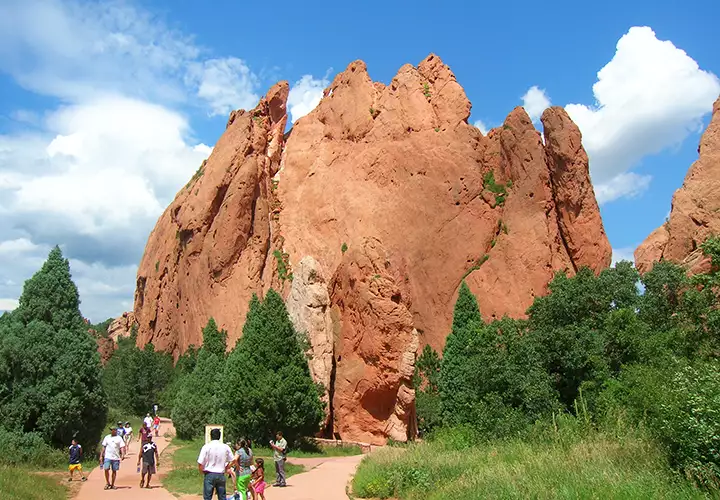
The Dakota Wall at Garden of the Gods, pushed up by the rising Rockies
During the Paleogene there were several episodes of the rise and fall of the Rocky Mountains. The first big push was about 65 million years ago. That uplift broke along a line marked by a tilted Dakota sandstone ridge that runs from Canada to Mexico on the eastern side of today's Rockies. The mountains that rose to the west eroded over the next 20 million years.
The granite mass of the southern Sangre de Cristo Mountains (in northern New Mexico) was intruded through upper layers of sandstone and sediments beginning about 45 million years ago. The folding that pushed up the rest of the Sangre de Cristo chain happened about 25 million years ago. What's exposed through most of the northern Sangre's (in Colorado) is rock from Pennsylvanian-Permian times. An exception is the area around Mt. Blanca. The Blanca Massif itself is formed of granite laid down about 1.3 billion years ago while the stocks of the Silver Mountain complex and the Spanish Peaks (to the east, across the fault lines that outline the Sange de Cristo's in the area) are composed of volcanic materials intruded about 23 million years ago and exposed by erosion and uplift since. Beyond the north end of the Sangre's, the Antero complex is another large stock that was also emplaced about 23 million years ago.
25 million years ago in the west, the San Juan Mountains area in southwestern Colorado was a mass of volcanic activity with peaks rising as high as today's Mt. Everest. It's that volcanic activity that has turned parts of the San Juan's into major mining districts while the folding and uplift that created most of the Sangre's didn't.
Late in the Paleogene, along the West Coast the triple junction and Baja BC terrane migrated rapidly northward, pushing the Quesnell and Stikine inboard terranes further north. Arc activity continued on Baja BC and across western Mexico but waned across Idaho and the Sierra Nevada. Fore arc sedimentation (Franciscan-Great Valley and similar units) continued into the late Paleogene along the western Cordilleran margin. Uplift of the Coast Range plutonic complex generated deep-sea alluvial fan deposits (Chugach flysch) onto the floor of the Gulf of Alaska.
By 40 million years ago, many terranes had approached their present latitude with respect to North America. The Olympic terrane accreted onto Washington about 50 million years ago. The California borderlands remained active while basins inboard of the Coast and Peninsular Ranges filled with thick marine and continental deposits.
The Mendocino Fracture Zone on East Pacific Rise collided with the North American plate about 40 million years ago and added its materials to the Coast Range Complex.
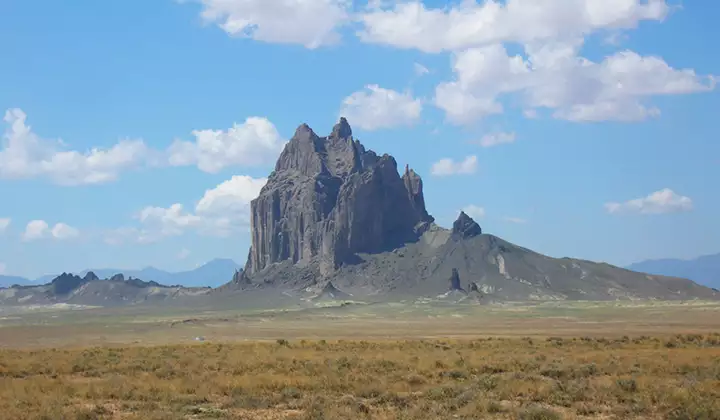
Shiprock, a volcanic plug from the Oligocene, now a Diné Sacred Mountain
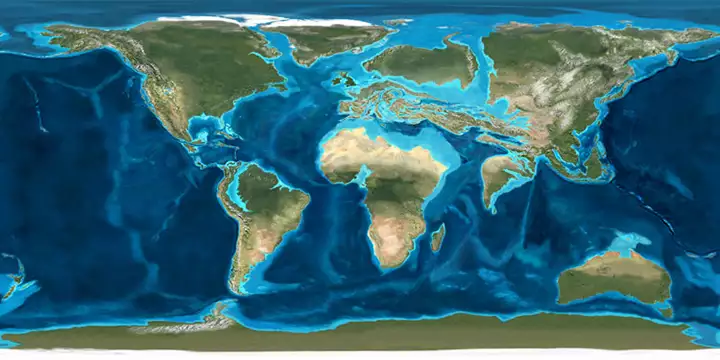
Earth, 50 million years ago
Maps © Ron Blakey, NAU Geology, Deep Time Maps
Bottom map courtesy of Ron Blakey, NAU Geology, CCA-by-SA 4.0 License
